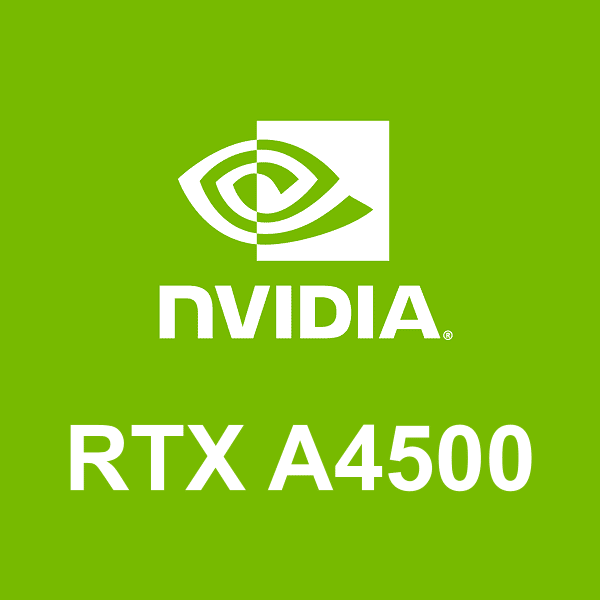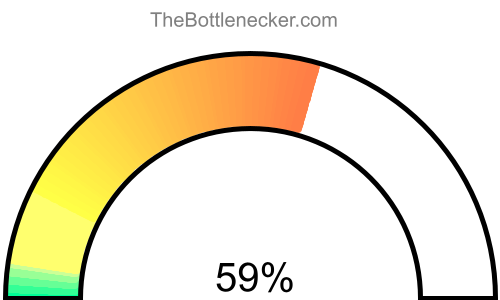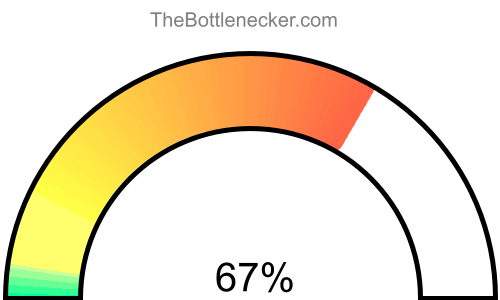GreedFall bottleneck calculator
AMD A6-5357M and NVIDIA RTX A4500
1. Select game
Currently selected:

GreedFall
2. Select processor
Currently selected:
AMD A6-5357M
3. Select graphic card
Currently selected:
NVIDIA RTX A4500
4. Select resolution
Currently selected:
7680 × 4320 resolution
(1 monitor)
Calculation result
Bottleneck percentage
When configuring a high-performance computing setup, it's imperative to ensure that each hardware component is well-matched with its counterparts to provide seamless and optimal system performance. In the case of the AMD A6-5357M and NVIDIA RTX A4500 in the GreedFall with 7680 × 4320 and 1 monitor, it appears that hardware compatibility has been achieved superbly, as evidenced by the calculated bottleneck percentage of 0%.

To elaborate, a bottleneck occurs when one component restricts the maximum efficiency of another, leading to suboptimal performance and reduced system effectiveness. However, in this configuration, that is not a concern. Any bottleneck percentage below 5% is generally deemed insignificant, and our current bottleneck value sits at 0%, which means you can expect superior system performance.
Processor and graphic card utilizations
In a computing setup featuring the AMD A6-5357M and NVIDIA RTX A4500, under the context of GreedFall with a screen resolution of 7680 × 4320 and 1 monitor, the processor is expected to have an utilization rate of 83.2%, while the graphics card is projected to be utilized at 81.7%.
It's crucial to understand that these figures signify theoretical maximums based on typical CPU-to-GPU workload distribution ratios for certain tasks or gaming experiences. Achieving these high levels of utilization in real-world settings can be a challenging endeavor.

Playability
- Playable
- Frames per second
-
A game is considered "playable" if it can consistently run at 60 FPS on high settings. This ensures a smooth and visually appealing gaming experience free from lags or stutters.
Heatmap of bottleneck
The heatmap serves as a graphical representation to further confirm the compatibility between the AMD A6-5357M and NVIDIA RTX A4500. On this heatmap, the x-axis corresponds to the CPU Score, and the y-axis corresponds to the GPU Score. In a perfectly balanced system such as this, the intersection point of the AMD A6-5357M and NVIDIA RTX A4500 will fall within the "no bottleneck zone."
The "no bottleneck zone" is an area on the heatmap where the hardware components are not only compatible but are also optimally matched to provide peak system performance. When the intersection of the CPU and GPU scores resides in this zone, it is a strong indicator that the system is balanced and will deliver excellent performance for GreedFall. The presence of both the AMD A6-5357M and NVIDIA RTX A4500 in this zone confirms that neither component will hinder the performance of the other, leading to a seamless and highly efficient computing experience.

Mapping your AMD A6-5357M CPU Score against the NVIDIA RTX A4500 GPU Score can provide a comprehensive view of how these components interact and where bottlenecks are most likely to happen. Leveraging this heatmap data could guide you in making more balanced hardware selections suitable for your specific computing needs.
General bottleneck calculations
The bottleneck calculations presented here are geared specifically towards in-game scenarios, providing valuable insights into how your hardware configuration could impact gaming performance. However, it's crucial to understand that bottlenecks can manifest in various types of tasks and applications. Below, you will find bottleneck calculations segmented into three primary categories: General Tasks, CPU Intensive Tasks, and GPU Intensive Tasks. This segmentation allows for a more nuanced understanding of how your system's components interact under different types of workloads.
General tasks bottleneck result
For general tasks that include web browsing, video streaming, office applications, and basic multitasking, the bottleneck result offers a comprehensive look at how well your CPU and GPU are balanced. If the bottleneck percentage leans heavily towards either the CPU or GPU, it might be beneficial to consider an upgrade for the more taxed component to ensure smoother system performance.
CPU intensive tasks bottleneck result
When it comes to CPU intensive tasks, such as video editing, 3D rendering, or scientific computing, the bottleneck calculation primarily focuses on whether your processor is powerful enough to handle these workloads efficiently. Here, a high bottleneck percentage for the CPU would indicate that your processor is the limiting factor, making tasks slower than they could be with a more robust CPU.
GPU intensive tasks bottleneck result
In scenarios involving GPU intensive tasks—like advanced gaming, graphical rendering, or video processing—the bottleneck calculation highlights the efficiency of your graphics card in relation to the overall system. A high bottleneck percentage on the GPU side would suggest that your graphics card is the limiting component, potentially hindering your system's ability to deliver optimal graphical performance.
Bottleneck solutions
Replace processor
If your graphic card is causing the bottleneck but you're considering replacing your processor, reconsider this approach. Unless your processor is already on the verge of becoming outdated, upgrading it might not offer a significant performance boost, particularly in graphics-heavy tasks.
- AMD A8-5550M Full details
- Intel Core i3-5015U Full details
- Intel Core i3-4030U Full details
- Intel Core M-5Y10 Full details
- Intel Core i3-3110M Full details
- AMD A8-7100 Full details
- Intel Core i3-4010U Full details
- AMD A10-4655M Full details
- Intel Core i7-720QM Full details
- AMD A4-7210 Full details
- Intel Core i3-4005U Full details
- AMD A6-5200 Full details
- AMD Phenom II X920 Full details
- AMD A6-6310 Full details
- AMD A8-4500M Full details
- AMD A8-3550MX Full details
- AMD Phenom II N970 Full details
- Intel Core i7-2617M Full details
- Intel Core i3-3120M Full details
- Intel Pentium 4425Y Full details
- Intel Core i5-2557M Full details
- Intel Core i5-520M Full details
- AMD A6-7310 Full details
- AMD A10-7300 Full details
- Intel Celeron 3965U Full details
- AMD A8-6410 Full details
- AMD A10-5745M Full details
- Intel Core i7-820QM Full details
- Intel Core i3-4000M Full details
- AMD GX-420CA SOC Full details
- AMD GX-424CC SOC Full details
- AMD PRO A4-3350B Full details
- AMD A8-5557M Full details
- Intel Core i5-540M Full details
- AMD A8-7410 Full details
- Intel Core i7-740QM Full details
- Intel Core M-5Y70 Full details
- Intel Core i7-2637M Full details
- Intel Celeron 5205U Full details
- Intel Core i5-2467M Full details
- AMD A6-8500P Full details
- AMD A6-3430MX Full details
- AMD A8-3520M Full details
- Intel Core i7-620LM Full details
- Intel Celeron 3867U Full details
- AMD A4-6210 Full details
- AMD A9-9420 Full details
- Intel Celeron 3955U Full details
- AMD A9-9425 Full details
- Intel Core i7-640LM Full details

Impact of Changing Screen Resolution
Increasing the resolution in this scenario will only make the bottleneck worse, as the GPU will be under even more stress, leading to lower frame rates and reduced graphical quality. It won't significantly ease the load on the already underutilized processor.
Read moreReplace graphic cards
When the graphic card becomes a system bottleneck, upgrading it can provide a significant boost in performance. Opt for a card that better matches the capabilities of your processor to get a more balanced system. This will also enable you to run games and applications at higher settings, offering a vastly improved user experience.
- NVIDIA GeForce RTX 4080 Full details
- NVIDIA RTX 5000 Ada Generation Full details
- NVIDIA RTX 4000 Ada Generation Full details
- AMD Radeon RX 7900M Full details
- NVIDIA GeForce RTX 4070 Full details
- NVIDIA RTX 3500 Ada Generation Full details
- NVIDIA GeForce RTX 3080 Ti Full details
- NVIDIA GeForce RTX 3070 Ti Full details
- NVIDIA GeForce RTX 4060 Full details
- NVIDIA RTX A5500 Full details
- NVIDIA GeForce RTX 3080 Full details
- NVIDIA RTX 3000 Ada Generation Full details
- NVIDIA RTX A5000 Full details
- NVIDIA GeForce RTX 3070 Full details
- NVIDIA RTX 2000 Ada Generation Full details
- NVIDIA RTX A4000 Full details
- AMD Radeon RX 6800S Full details
- AMD Radeon RX 6850M XT Full details
- NVIDIA GeForce RTX 2080 Full details
- AMD Radeon RX 6700S Full details
- AMD Radeon RX 6650M Full details
- NVIDIA GeForce RTX 4050 Full details
- NVIDIA Quadro RTX 5000 Full details
- AMD Radeon RX 7600S Full details
- NVIDIA GeForce RTX 2070 Super (Max-Q Design) Full details
- NVIDIA RTX 1000 Ada Generation Full details
- NVIDIA GeForce RTX 2080 Super (Max-Q Design) Full details
- AMD Radeon RX 6600M Full details
- NVIDIA Quadro RTX 5000 (Max-Q Design) Full details
- NVIDIA RTX A3000 Full details
- AMD Radeon RX 6700M Full details
- NVIDIA GeForce RTX 3060 Full details
- AMD Radeon RX 6800M Full details
- NVIDIA GeForce RTX 2080 (Max-Q Design) Full details
- NVIDIA Quadro RTX 4000 (Max-Q Design) Full details
- NVIDIA Quadro RTX 4000 Full details
- NVIDIA GeForce RTX 2070 Full details
- NVIDIA Quadro P5200 Full details
- NVIDIA GeForce RTX 2070 (Max-Q Design) Full details
- Intel Arc A770M Full details
- NVIDIA GeForce RTX 2060 Full details
- NVIDIA GeForce GTX 1080 (Max-Q Design) Full details
- AMD Radeon RX 7600M XT Full details
- NVIDIA Quadro RTX 3000 Full details
- NVIDIA RTX A2000 Full details
- NVIDIA GeForce GTX 1070 Full details
- NVIDIA GeForce RTX 3050 Ti Full details
- NVIDIA GeForce GTX 1660 Ti Full details
- NVIDIA GeForce GTX 1070 (Max-Q Design) Full details
- NVIDIA RTX A1000 Full details

Impact of Changing Screen Resolution
If your graphics card is bottlenecking the system, lowering the screen resolution will allow the card to handle data more efficiently, resulting in higher frames per second. However, it's worth noting that lower resolutions will require less data processing from the CPU, which could create a new bottleneck there.
Read moreBottleneck calculator types
Select purpose bottleneck calculator
Before selecting a bottleneck calculator, consider your primary computing tasks. For general activities like web browsing and office work, the calculator evaluates the balance between your CPU and GPU. If you focus on CPU-intensive tasks like video editing or 3D rendering, the tool will highlight processor performance. For GPU-centric tasks such as gaming or graphical rendering, it will assess the efficiency of your graphics card. Choose the appropriate calculator to accurately identify potential system bottlenecks for your specific use-case.
Select game bottleneck calculator
By selecting a game from the list, the calculator will analyze potential bottlenecks specifically tailored to that game's system requirements and graphical demands. This allows you to optimize your setup for a smoother, more responsive gaming experience. Choose the game that aligns with your interests to get the relevant bottleneck analysis.









































